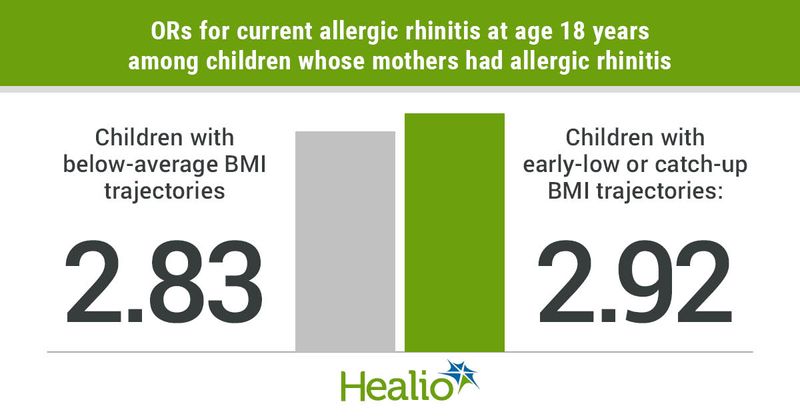Risk for allergic rhinitis linked to early BMI trajectory, maternal history
Infants with early-low and catch-up or below-average BMI growth, along with a mother with allergic rhinitis, had an increased risk for allergic rhinitis by age 18 years, according to a study published in Pediatric Allergy and Immunology.
“A number of studies have found that higher BMI at a specific time point is associated with an increased risk [for] allergic diseases outcomes, possibly because high levels of adiposity led to chronic inflammation,” Chia-Lun Chang, MSc, of the allergy and lung health unit at the Centre for Epidemiology and Biostatistics, and Adrian J. Lowe, PhD, MPH, a principal research fellow in allergic disease and epidemiology, both at Melbourne School of Population and Global Health, told Healio in a statement.


“However, we know that BMI changes dramatically, particularly in early life, but few studies have focused on BMI growth patterns. Recent research found that BMI trajectories in the first 2 years of life influence the risk [for] asthma. It was unclear whether these trajectories were also associated with eczema, food allergies and allergic rhinitis,” Chung and Lowe said.
The study involved 620 full-term infants who had a first-degree relative with a history of eczema, asthma, allergic rhinitis or food allergy; 60.5% of mothers and 45.8% of fathers had a history of allergic rhinitis at baseline.
Mothers were surveyed 18 times during the first 2 years and then annually when the children were aged 3 to 7 years. Parents completed questionnaires again when children were aged 12 years, and children completed questionnaires when aged 18 years.
The children also underwent skin prick tests to cow’s milk, egg white, peanut, dust mite, rye grass and cat dander at age 6, 12 and 24 months and age 12 years and to cashew, shellfish, mixed grass pollen, Alternaria, Cladosporium, Hormodendrum and Penicillium at age 18 years.
During the first 2 years of age, researchers classified the children into persistently low (13.6%), early-low and catch-up (17.6%), below-average (29.4%), average (24.9%) or persistently high (14.5%) BMI trajectories.
Allergic rhinitis increased in prevalence from 15.8% at age 6 years to 37.2% at age 12 years and then plateaued at age 18 years at 36.3%, with prevalence associated with atopy, although the researchers found no strong association between the BMI trajectories in the first 2 years of life and current allergic rhinitis at these time points.
But among the children whose mothers had allergic rhinitis, those with below-average (OR = 2.83; 95% CI, 1.34-5.96) and early-low and catch-up (OR = 2.92; 95% CI, 1.18-7.23) trajectories demonstrated an increased risk for current allergic rhinitis at age 18 years compared with those with an average trajectory.
Children with a persistently high trajectory had increased risks for allergic rhinitis and atopic rhinitis at age 18 years throughout the study period as well. The researchers noted that an earlier study of theirs using the same cohort found an increased risk for asthma at age 18 years among children in the early-low and catch-up and persistently high groups.
The researchers did not find any clear pattern of associations between BMI trajectories and eczema or food allergy outcomes. However, they noted that there was relatively limited power in their study.
According to the researchers, interactions between poor intrauterine growth, failure to thrive and maternal allergies may influence the risk for allergic rhinitis, although they cautioned that their results require replication.
“Our findings suggest that children with a maternal history of allergic rhinitis and belonging to specific BMI trajectories require close monitoring, as these children may be at higher risk [for] developing allergic rhinitis at age 18 [years],” Chang and Lowe said.
The benefits of monitoring BMI during early childhood and avoiding extreme levels of growth may include reducing the risk for allergic rhinitis, said the researchers, who called for additional work.
“Future research is needed to understand the biological mechanisms behind the interaction of maternal allergic rhinitis and early-life growth trajectories,” Chang and Lowe said.
Larger sample size cohorts are necessary because some of the associations they observed were imprecise, they continued, adding that BMI may not be a perfect proxy marker for adiposity because it does not differentiate between lean and fat mass.
“Future research could explore the association between early-life fat mass trajectory and allergic diseases,” Chang and Lowe said.
For more information:
Chia-Lun Chang, MS, can be reached at chang7@student.unimelb.edu.au.
Adrian J. Lowe, PhD, MPH, can be reached at lowea@unimelb.edu.au.
